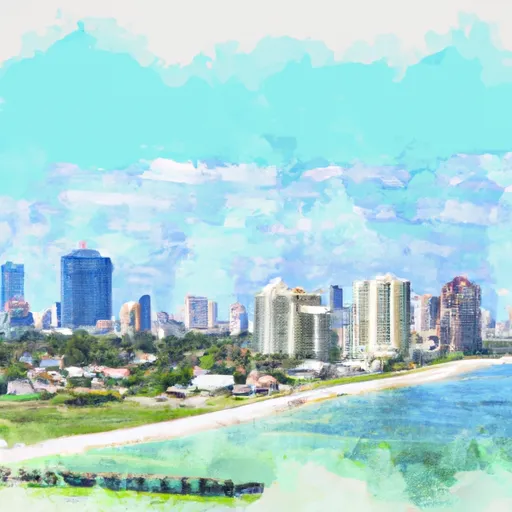-
 Snoflo Premium
Snoflo Premium
Get unlimited access to all our content
With no Ad interruptions! - Start Your Free Trial Login with existing account
Jensen-Beach
Eden Index
Climate
5.7
•
Recreation
3.7
•
Community
3.3
•
Safeguard
4.4/10

Jensen Beach, Florida is a charming coastal town located in Martin County. Known for its pristine beaches, abundant wildlife, and natural beauty, Jensen Beach offers a delightful experience for outdoor enthusiasts.
The climate in Jensen Beach is classified as a tropical savanna, characterized by hot and humid summers and mild winters. The average temperature ranges from 60°F (15°C) in winter to 90°F (32°C) in summer. The region receives about 50 inches of rainfall annually, with the wettest months being June through September.
Hydrologically, Jensen Beach is surrounded by water bodies like the Indian River Lagoon and St. Lucie River. These estuaries support diverse ecosystems and provide excellent opportunities for fishing, boating, and kayaking. The nearby Atlantic Ocean offers pristine beaches for swimming, sunbathing, and surfing.
Outdoor recreation in Jensen Beach extends beyond water activities. The area boasts several parks, nature preserves, and golf courses. The Savannas Preserve State Park, Hutchinson Island, and Jensen Beach Causeway Park are popular destinations for hiking, birdwatching, picnicking, and wildlife spotting.
In summary, Jensen Beach offers a tropical savanna climate, rich hydrological features, and a wide array of outdoor recreation opportunities, making it an ideal destination for nature lovers and adventure seekers alike.
What is the Eden Index?
The Snoflo Eden Index serves as a comprehensive rating system for regions, evaluating their desirability through a holistic assessment of climate health, outdoor recreation opportunities, and natural disaster risk, acknowledging the profound impact of these factors on livability and well-being.
Climate Health Indicator (CHI): 5.7
Jensen-Beach receives approximately
1545mm of rain per year,
with humidity levels near 85%
and air temperatures averaging around
24°C.
Jensen-Beach has a plant hardyness factor of
10, meaning
plants and agriculture in this region tend to thrive here all year round.
By considering the ideal temperature range, reliable water supplies, clean air, and stable seasonal rain or snowpacks, the Climate Health Indicator (CHI) underscores the significance of a healthy climate as the foundation for quality living.
A healthy climate is paramount for ensuring a high quality of life and livability in a region, fostering both physical well-being and environmental harmony. This can be characterized by ideal temperatures, reliable access to water supplies, clean air, and consistent seasonal rain or snowpacks.
Weather Forecast
Streamflow Conditions
East Florida Coastal
Area Rivers
East Florida Coastal
Snowpack Depths
East Florida Coastal
Reservoir Storage Capacity
East Florida Coastal
Groundwater Levels
Recreational Opportunity Index (ROI): 3.7
The Recreational Opportunity Index (ROI) recognizes the value of outdoor recreational options, such as parks, hiking trails, camping sites, and fishing spots, while acknowledging that climate plays a pivotal role in ensuring the comfort and consistency of these experiences.
Access to outdoor recreational opportunities, encompassing activities such as parks, hiking, camping, and fishing, is crucial for overall well-being, and the climate plays a pivotal role in enabling and enhancing these experiences, ensuring that individuals can engage in nature-based activities comfortably and consistently.
Camping Areas
| Campground | Campsites | Reservations | Toilets | Showers | Elevation |
|---|---|---|---|---|---|
| Sebastian Inlet State Park | None | 5 ft | |||
| Jonathan Dickinson State Park | None | 25 ft | |||
| Topeekeegee Yugnee County Park | 60 | 5 ft | |||
| St. Lucie Lock | None | 20 ft | |||
| Markham Park | 86 | 10 ft | |||
| Quiet Waters Park | None | 14 ft | |||
| Savannas Recreational Park | 56 | 16 ft | |||
| CB Smith Park | None | 6 ft | |||
| Easterlin Park | None | 3 ft | |||
| Phipps County Park | None | 14 ft |
Catastrophe Safeguard Index (CSI):
The Catastrophe Safeguard Index (CSI) recognizes that natural disaster risk, encompassing floods, fires, hurricanes, and tornadoes, can drastically affect safety and the overall appeal of an area.
The level of natural disaster risk in a region significantly affects safety and the overall livability, with climate change amplifying these risks by potentially increasing the frequency and intensity of events like floods, fires, hurricanes, and tornadoes, thereby posing substantial challenges to community resilience and well-being.
Community Resilience Indicator (CRI): 3.3
The Community Resilience Indicator (CRI) recognizes that education, healthcare, and socioeconomics are crucial to the well-being of a region. The CRI acknowledges the profound impact of these elements on residents' overall quality of life. By evaluating educational resources, healthcare accessibility, and economic inclusivity, the index captures the essential aspects that contribute to a thriving community, fostering resident satisfaction, equity, and social cohesion.

